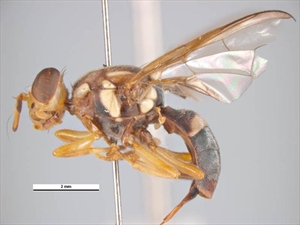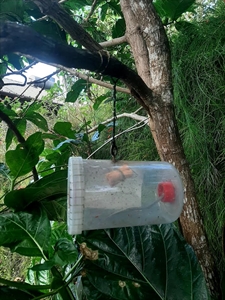- Restricted. Oceania. In Australia (under eradication except Queensland), French Polynesia, New Caledonia, Pitcairn.
- A very serious and invasive pest causing rots in >200 fruits, vegetables and wild species.
- Eggs laid (100/day) inside hosts just below surface. Maggots up to 7 mm long, curl into U-shape and jump. Fall to ground to pupate. Adults 5-8 mm long, 10-12 mm wingspan, red-brown thorax, two yellow stripes near the sides, black spots below antennae, clear wings.
- Spread on the wing (strong flier), by people while travelling, and international trade in fruit.
- Natural enemies: parasitism up to 30% but not effective in supressing populations.
- Biosecurity: technologies and schemes to facilitate trade including:
- post-harvest measures: HTFA (high temperature forced air); low temperatures; insecticide dips; irradiation.
- area freedom: supported by cultural and chemical measures, e.g., pheromone traps on defined grids; frequent monitoring; public awareness.
- area-wide management: trapping; protein-bait/insecticide sprays; male annihilation (concentrated trapping); cover sprays as a last resort (e.g., dimethoate); community application of cultural controls; public awareness.
- Cultural control: (i) monitor - trap male flies with pheromone (cure-lure); regularly check ripe fruit; (ii) proteins baits – use yeast autolysate and insecticide spray; (iii) hygiene – bag fruit; harvest early; pick up fallen fruit, and destroy.
- Eradication: define quarantine area; control fruit movement; remove fruit from trees and collect fallen fruit, protein bait/insecticide sprays; male annihilation; possibly SIT (sterile insect technique)






